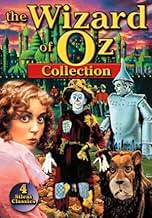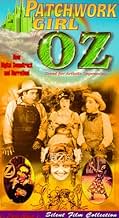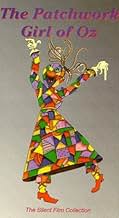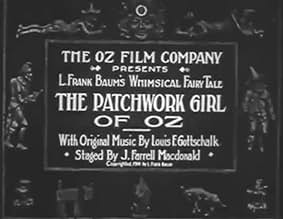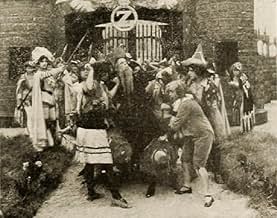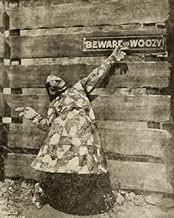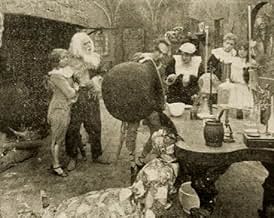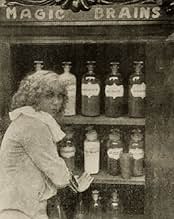Ajouter une intrigue dans votre langueOjo and Unc Nunkie are out of food, so they decide to journey to the Emerald City where they will never starve.Ojo and Unc Nunkie are out of food, so they decide to journey to the Emerald City where they will never starve.Ojo and Unc Nunkie are out of food, so they decide to journey to the Emerald City where they will never starve.
Leontine Dranet
- Margolotte, his wife, who makes the Patchwork Girl
- (as Haras Dranet)
Richard Rosson
- Danx, a Noble Munchkin
- (as Dick Rosson)
Bert Glennon
- The Scarecrow
- (as Herbert Glennon)
Hal Roach
- The Cowardly Lion
- (as Al Roach)
- …
Dave Anderson
- The Hungry Tiger
- (as Andy Anderson)
Pierre Couderc
- Scraps, the Patchwork Girl
- (as The Marvelous Couderc)
Avis en vedette
L. Frank Baum himself produced and wrote this adaptation of his own Oz book, a full quarter century before Judy Garland strolled the yellow brick road. What survives is an intriguing artifact from cinema's infancy, antiquated in style and naive in sentiment, but compensating with plenty of charm for what it lacks in sophistication. The influence of theater can still be seen in the histrionic acting and static camera set-ups, but the affection Baum lavished on his creations (munchkins, magicians, 'hoppers', the 'woozy') is clearly evident, even today. His fertile imagination, reinforced by some clever (if primitive) camera tricks, makes this an enchanting fantasy with more than merely academic interest for students of early film history.
A feast of quaint but super-hectic activity, presented before a solidly stationary camera (except for the effective concluding shot), this is a dated and none too interesting attempt by author L. Frank Baum himself to transfer his Oz from the printed page to the cinema. He is let down by the totally unimaginative direction (from well-known character actor J. Farrell MacDonald), the almost entirely stationary camera-work (though there are a couple of clever touches here and there) with its long, boring takes, and the inappropriately over-the-top enthusiasm of almost all the players.
As a curiosity, the movie would make a tolerable two-reeler, but 65 minutes of repetitious jumping, sliding, running, kicking, dancing, climbing, gallivanting, funning and frolicking, is, despite the picturebook tints and novel costumes of its picturebook illustrations brought to life, just far too much of a mediocre thing.
Now, if the highly imaginative original drawings by W.W. Denslow that accompanied Baum's first and most famous venture into the land of Oz, The Wonderful Wizard of Oz (1900), had been brought to life rather than the conventional Victoriana here displayed, the film would doubtless have captured an audience's interest far more than this ultimately wearisome parade. Unfortunately, there was no chance of that happy eventuality. Baum and Denslow had a falling out in 1901 when both men claimed that the instant success of Oz was primarily due to their own input. Therefore it's no surprise that producer Baum made it his business to ensure the movie's visuals were as far removed from Denslow's creations as possible.
As a curiosity, the movie would make a tolerable two-reeler, but 65 minutes of repetitious jumping, sliding, running, kicking, dancing, climbing, gallivanting, funning and frolicking, is, despite the picturebook tints and novel costumes of its picturebook illustrations brought to life, just far too much of a mediocre thing.
Now, if the highly imaginative original drawings by W.W. Denslow that accompanied Baum's first and most famous venture into the land of Oz, The Wonderful Wizard of Oz (1900), had been brought to life rather than the conventional Victoriana here displayed, the film would doubtless have captured an audience's interest far more than this ultimately wearisome parade. Unfortunately, there was no chance of that happy eventuality. Baum and Denslow had a falling out in 1901 when both men claimed that the instant success of Oz was primarily due to their own input. Therefore it's no surprise that producer Baum made it his business to ensure the movie's visuals were as far removed from Denslow's creations as possible.
You really have to look at "The Patchwork Girl of Oz" in context, otherwise you'll just dismiss it as a dull and incomprehensible movie. But, back in 1914, it was a rather impressive tale--but one that even audiences back then probably struggled to understand unless they'd read the Frank Baum story. Heck, I tried watching it was was TOTALLY confused until I read a summary of the story on the internet! That's because the narrative is really scant--with almost no intertitle cards. Instead, it's shown as a series of tenuously connected vignettes which are described on the card and then acted out...as was the style up until about 1914 or a bit later. It comes off almost like a slide show that is acted out for the audience! This certainly is NOT all that entertaining and too often the characters just cavort about aimlessly or do acrobatics instead of acting--and it comes off pretty poorly. BUT, again, it was pretty much the style of the day. The ladies in the film and sets and 'magic' were pretty similar to the work done a decade earlier by the groundbreaking French film maker Georges Méliès. By 1914, these amazing effects and story telling really were a a bit passé--definitely on their way out--which might explain why the film was a critical flop--that, and the fact that the audience probably had no idea what was occurring on screen! Interesting from a historical perspective and having excellent production values for the time, but still very easy to skip unless you adore very early silent films.
"The Patchwork Girl of Oz" was the most racist of L. Frank Baum's Oz novels, featuring the Tottenhots (stereotyped Africans) and also an ambulatory Victrola phonograph that sings ragtime songs in an offensive "darky" dialect. Fortunately, this film version (written and directed by Baum himself) omits the ragtime racism and reconceives the Tottenhots so that they're only barely recognisable as racist stereotypes. This is a fun movie, which I recommend without reservation for adults and kids.
It is of course rather a crude film, even by silent standards, and hampered by cross-sexed casting in both directions. The hero of the film, a Munchkin boy named Ojo, is obviously played by an adult woman. The Patchwork Girl, Scraps, is very obviously played by a man. However, Pierre Couderc, the French acrobat who plays this role, gives an incredible performance. He effortlessly turns backward handsprings and shoulder kips, his performance made even more amazing by the bulky costume and elaborate hoop skirt he's wearing. There's one very amusing sight gag when the Patchwork Girl and the Scarecrow meet for the first time. Ah, true love!
The plot of this film is a simplified version of the Oz novel. Orphan boy Ojo and his elderly Unk Nunkie visit Doctor Pipt the magician. Pipt has invented the Powder of Life, which brings life to any inanimate object it touches. (Why doesn't it animate its own container?) Pipt's wife Margolotte has made a girl dummy out of patchwork quilts, which will become Margolotte's maidservant after Pipt animates it. When Pipt brings the Patchwork Girl to life, her exuberance causes her accidentally to spill another elixir over Margolotte and Unk Nunkie, which transforms them into marble statues. Dr Pipt can't reverse the enchantment until he mixes another batch of the Powder of Life, which requires certain ingredients ... including three hairs from a Woozy's tail. Ojo sets forth to obtain the ingredients.
Animal impersonator Fred Woodward does amazing work as several different animals. Woodward is the spiritual father of Janos Prohaska, a 1960s stuntman who specialised in portraying animals and aliens. One of the roles Woodward plays here is the Woozy, a creature whose body is made of cardboard boxes. (This is a very low-budget movie, but that's part of its charm.) The squared-off look of the Woozy in the Oz book's illustrations was obviously inspired by the low-budget costume worn by Woodward in this movie.
TRIVIA NOTE: Watch for Harold Lloyd and Hal Roach Snr (very early in their careers) in grass skirts and body paint as two of the Tottenhots. Shortly after this movie was filmed, Roach received the inheritance which enabled him to set up his own film studio. Juanita Hansen, later a Roach actress, appears briefly here. Also glimpsed is Charles Ruggles, who would soon get his big break as Private Files in L. Frank Baum's stage musical "Tik-Tok in Oz".
"The Patchwork Girl of Oz" is an absolute delight, which adults and children will enjoy in repeated viewings. There are some impressive sets and costumes, despite the low budget. Jaded modern audiences will sneer at the very crude special effects, but I would rather watch this movie instead of a certain overrated MGM musical starring Liza Whatsername's mother.
It is of course rather a crude film, even by silent standards, and hampered by cross-sexed casting in both directions. The hero of the film, a Munchkin boy named Ojo, is obviously played by an adult woman. The Patchwork Girl, Scraps, is very obviously played by a man. However, Pierre Couderc, the French acrobat who plays this role, gives an incredible performance. He effortlessly turns backward handsprings and shoulder kips, his performance made even more amazing by the bulky costume and elaborate hoop skirt he's wearing. There's one very amusing sight gag when the Patchwork Girl and the Scarecrow meet for the first time. Ah, true love!
The plot of this film is a simplified version of the Oz novel. Orphan boy Ojo and his elderly Unk Nunkie visit Doctor Pipt the magician. Pipt has invented the Powder of Life, which brings life to any inanimate object it touches. (Why doesn't it animate its own container?) Pipt's wife Margolotte has made a girl dummy out of patchwork quilts, which will become Margolotte's maidservant after Pipt animates it. When Pipt brings the Patchwork Girl to life, her exuberance causes her accidentally to spill another elixir over Margolotte and Unk Nunkie, which transforms them into marble statues. Dr Pipt can't reverse the enchantment until he mixes another batch of the Powder of Life, which requires certain ingredients ... including three hairs from a Woozy's tail. Ojo sets forth to obtain the ingredients.
Animal impersonator Fred Woodward does amazing work as several different animals. Woodward is the spiritual father of Janos Prohaska, a 1960s stuntman who specialised in portraying animals and aliens. One of the roles Woodward plays here is the Woozy, a creature whose body is made of cardboard boxes. (This is a very low-budget movie, but that's part of its charm.) The squared-off look of the Woozy in the Oz book's illustrations was obviously inspired by the low-budget costume worn by Woodward in this movie.
TRIVIA NOTE: Watch for Harold Lloyd and Hal Roach Snr (very early in their careers) in grass skirts and body paint as two of the Tottenhots. Shortly after this movie was filmed, Roach received the inheritance which enabled him to set up his own film studio. Juanita Hansen, later a Roach actress, appears briefly here. Also glimpsed is Charles Ruggles, who would soon get his big break as Private Files in L. Frank Baum's stage musical "Tik-Tok in Oz".
"The Patchwork Girl of Oz" is an absolute delight, which adults and children will enjoy in repeated viewings. There are some impressive sets and costumes, despite the low budget. Jaded modern audiences will sneer at the very crude special effects, but I would rather watch this movie instead of a certain overrated MGM musical starring Liza Whatsername's mother.
The enjoyable story and characters in "The Patchwork Girl of Oz" makes it a fun movie to watch, and it is also pretty resourceful for its era. It does have a lot of rough edges and shows some signs of age, but its energy and creativity more than make up for those. As with all of the Oz features made by L. Frank Baum's own studio, it shows his influence in the way that the fantasy world of Oz is brought to life with enthusiasm.
As with most of Baum's Oz stories, it has plenty of oddball characters and offbeat developments. A couple of odd casting choices add to the curious feel, with Pierre Couderc making Scraps look much like a male, and Violet Macmillan making Ojo seem more like a young girl. But they and the rest of the cast give their characters plenty of life, which really is more significant in a movie like this. As in the other Oz movies in the series, Fred Woodward also gets to perform a number of his costumed animal characters.
The story is one of Baum's most creative ones, telling a complex story in which the agendas and motivations of many different characters come into conflict. This adaptation is imaginative in using a lot of different techniques to reproduce the look of the characters, the magical events, and the hectic activity.
Much of it works rather well, and all of it represents a very good attempt for its time. Very few film-makers of the era ever tried to make a full-length picture out of such challenging fantasy material, and even if it has a fair number of rough edges, it remains a worthwhile and entertaining effort.
As with most of Baum's Oz stories, it has plenty of oddball characters and offbeat developments. A couple of odd casting choices add to the curious feel, with Pierre Couderc making Scraps look much like a male, and Violet Macmillan making Ojo seem more like a young girl. But they and the rest of the cast give their characters plenty of life, which really is more significant in a movie like this. As in the other Oz movies in the series, Fred Woodward also gets to perform a number of his costumed animal characters.
The story is one of Baum's most creative ones, telling a complex story in which the agendas and motivations of many different characters come into conflict. This adaptation is imaginative in using a lot of different techniques to reproduce the look of the characters, the magical events, and the hectic activity.
Much of it works rather well, and all of it represents a very good attempt for its time. Very few film-makers of the era ever tried to make a full-length picture out of such challenging fantasy material, and even if it has a fair number of rough edges, it remains a worthwhile and entertaining effort.
Le saviez-vous
- AnecdotesHarold Lloyd and Hal Roach, who both have minor roles in this film, met on this set in San Diego. Roach was impressed by Lloyd's energy and sought him out when he formed his production company The Rolin Film Company in July 1914 after receiving a small inheritance. Although their association was stormy, their association was ultimately one of the most successful in silent film history.
- GaffesThe character of Ojo is stated several times to be a boy, but is referred to as a girl in one of the dialogue caption cards.
- ConnexionsFeatured in American Masters: Harold Lloyd: The Third Genius (1989)
Meilleurs choix
Connectez-vous pour évaluer et surveiller les recommandations personnalisées
- How long is The Patchwork Girl of Oz?Propulsé par Alexa
Détails
- Durée1 heure 21 minutes
- Couleur
- Mixage
- Rapport de forme
- 1.33 : 1
Contribuer à cette page
Suggérer une modification ou ajouter du contenu manquant

Lacune principale
By what name was The Patchwork Girl of Oz (1914) officially released in Canada in English?
Répondre
